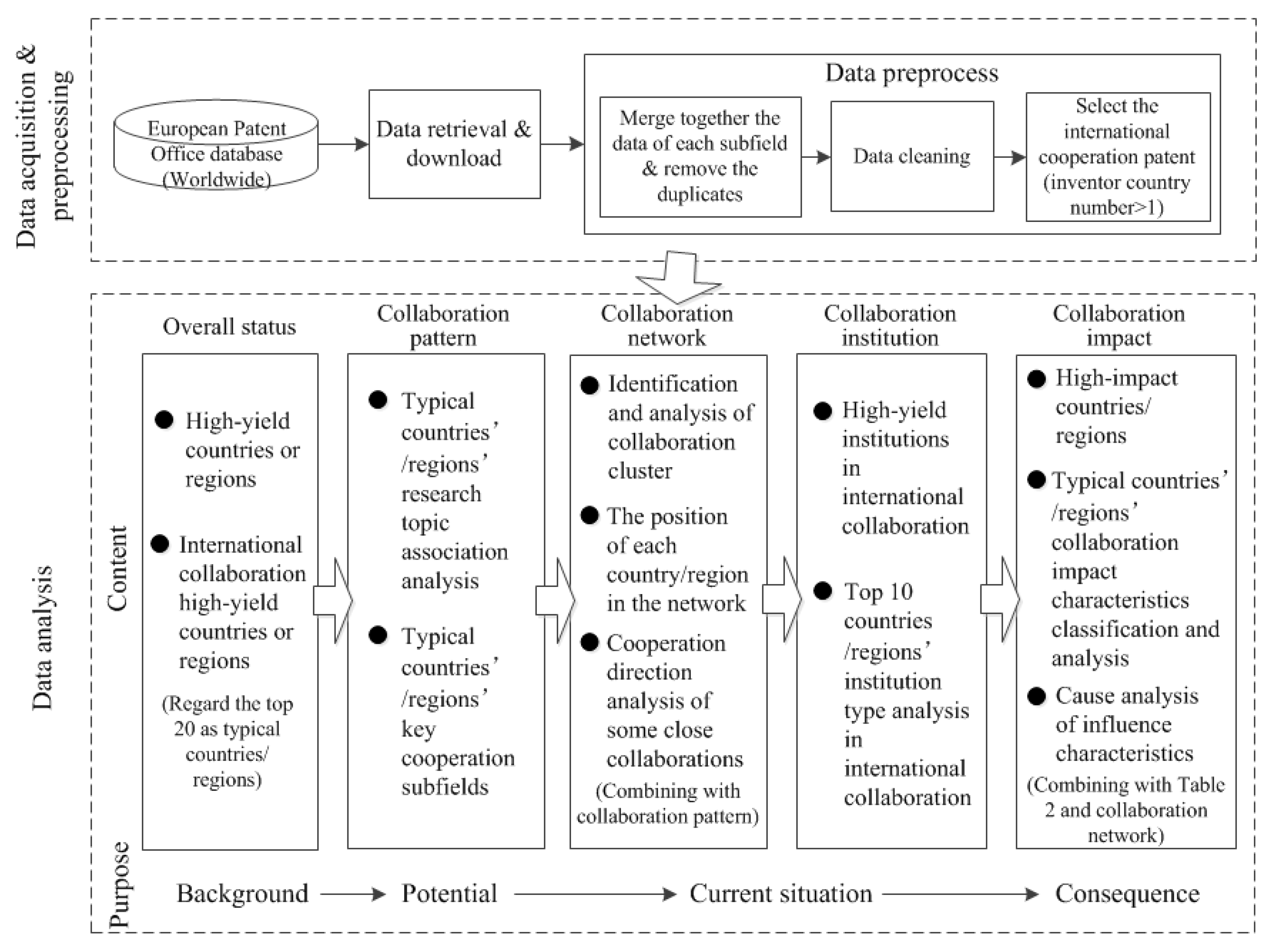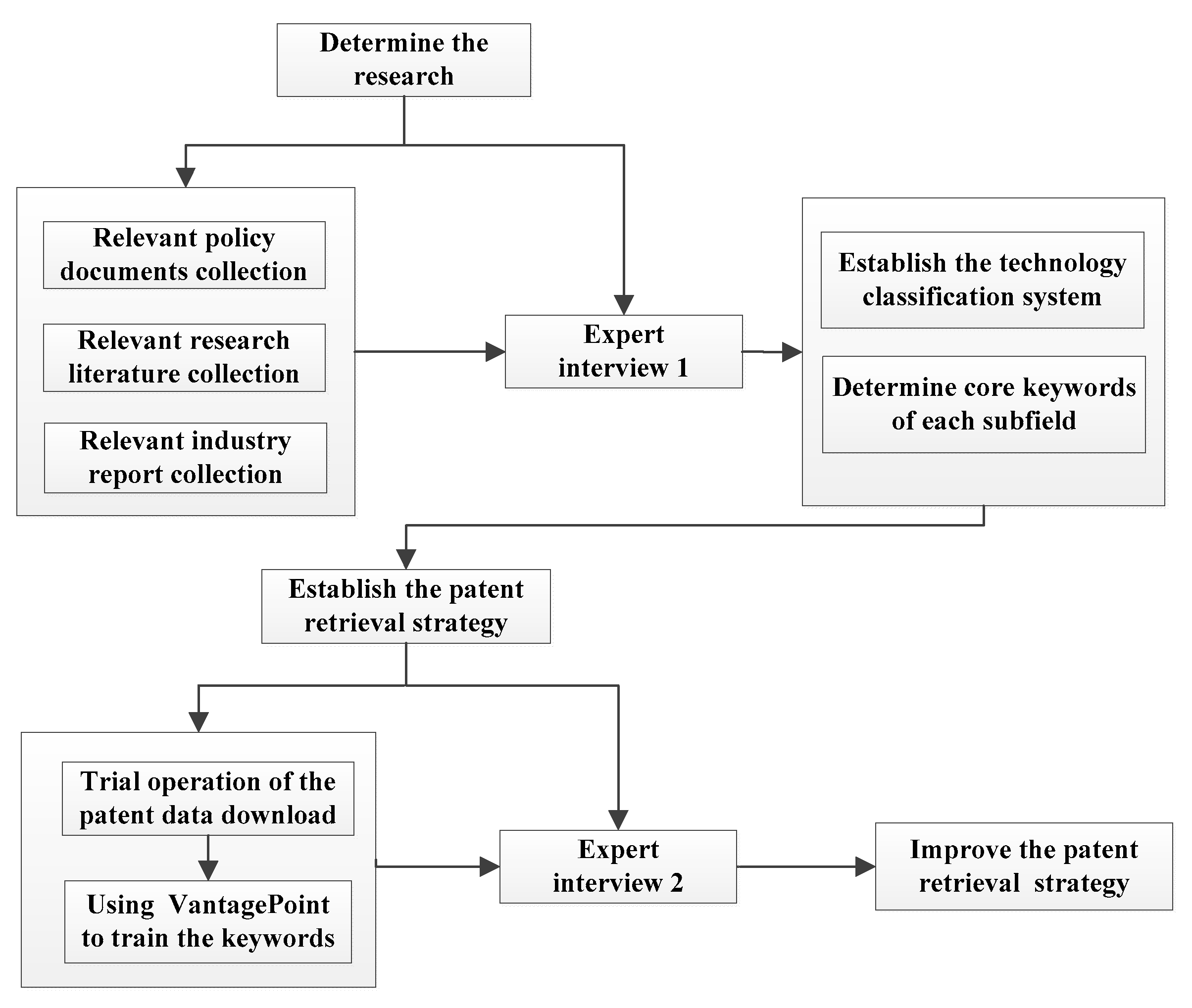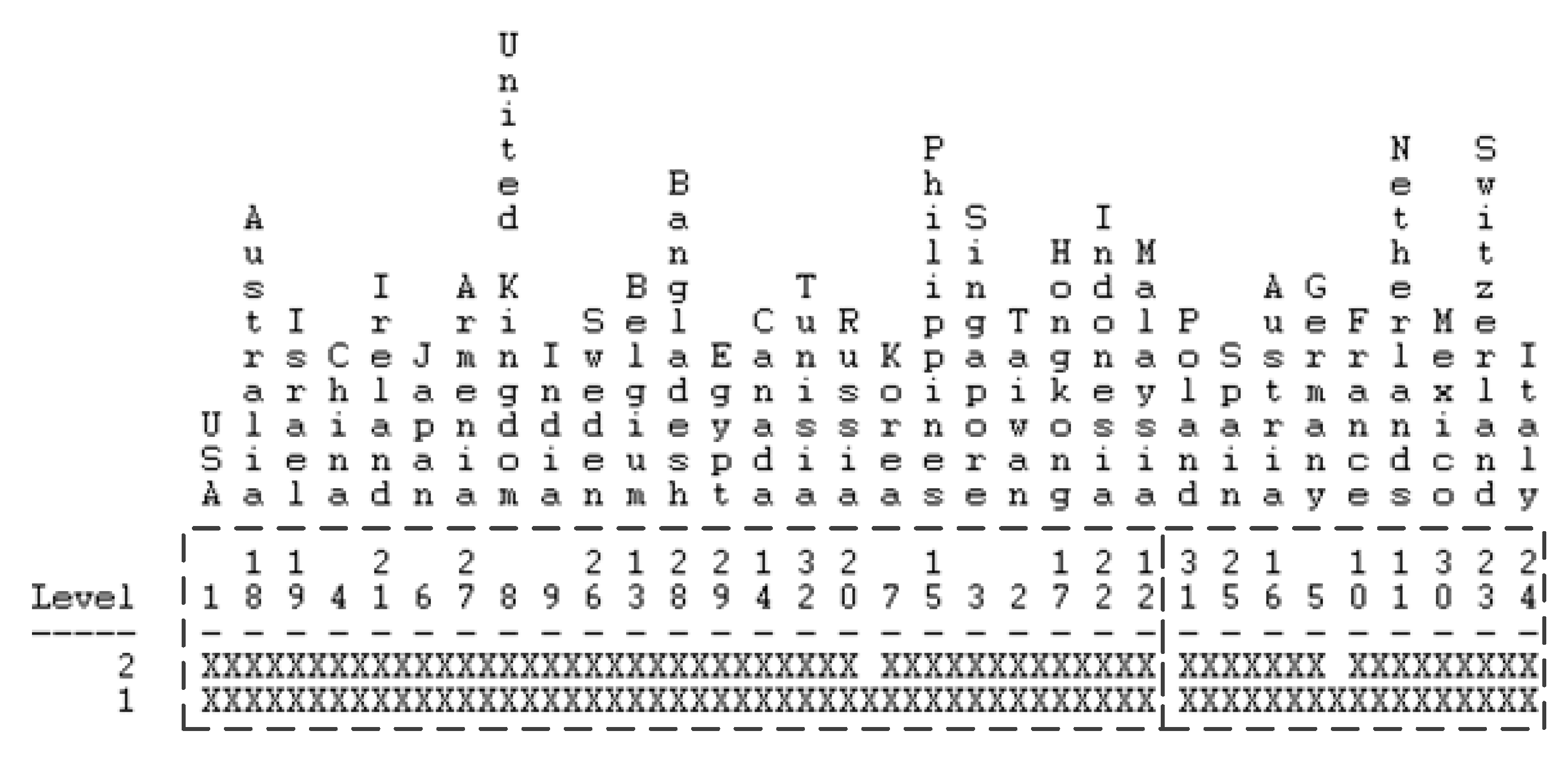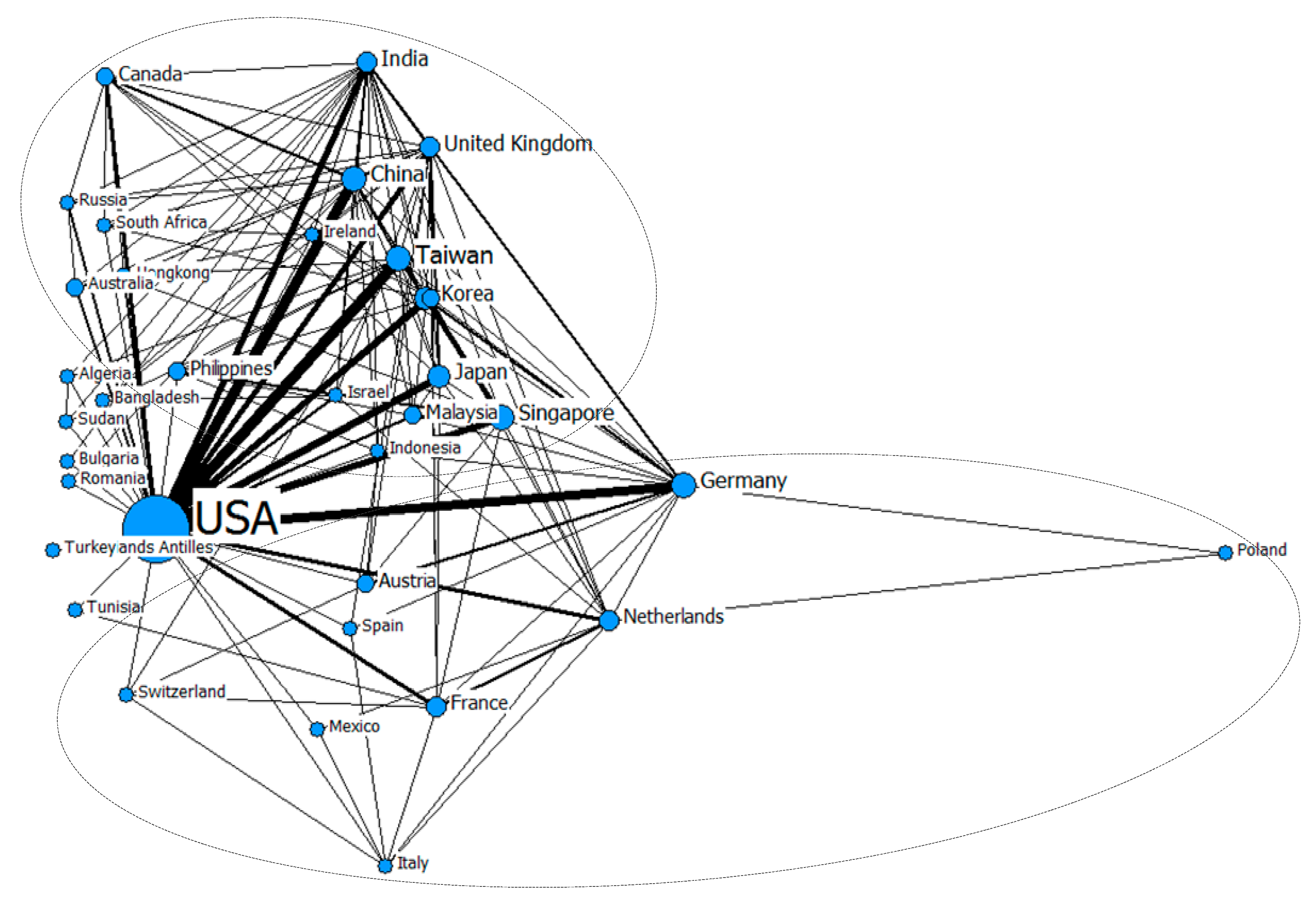1. Introduction
The Integrated Circuit (IC) industry is the foundation and power source of high-speed development in the information technology industry [
1] and it has infiltrated every area of national economic and social development. The technological level and development scale of a country’s IC industry has become the key for achieving competitive advantage and sustainable development for companies, economies, and societies [
2,
3]. For example, as one of the research directions of the IC industry, Radio Frequency Identification (RFID) technology is a catalyst which can promote big data analysis and application [
4]. RFID can revolutionize big data analytics, benefitting various sustainability themes: the use of big data analytics based on RFID technology in areas such as smart city, smart power grid, smart building, smart industry, supply chain analytics, and better logistics planning can effectively reduce the environmental stress from broader social and economic activities [
5,
6]. In addition, countries all over the world have accelerated the strategic adjustment for their economic structures after the international financial crisis, which makes the strategic adjustment fundamental, and the leading position of the IC industry more obvious. For instance, the USA regards the IC industry as one of the four major technical areas that can radically transform the manufacturing industry over the next 20 years [
7]. The European Union implemented its Micro- and Nanoelectronic Technology Industry Strategy Roadmap [
8]. Also, China issued the policy “Outline of Development of the National Integrated Circuit Industry” and a series of policy documents [
9,
10,
11] that promoted the status of the IC industry from inside the industry to the national level. As a result of the crucial technological and economic importance of its innovations, it is no surprise that this industry is the focus of many innovation researchers [
12]. Located in the middle of the IC industrial value chain [
13], the Integrated Circuit Manufacturing (ICM) industry is both technology- and capital-intensive, and the level of technological development also matters a great deal in this sector [
14,
15].
In fact, the ICM industry is experiencing a rapid technological development [
16,
17]. The number of transistors on a single chip is up to 10
9 orders in magnitude from 10 of thirty years ago [
18]. As ICM technologies become more complicated, it is impossible for any single institution to endure merely with its own patents and technologies [
15]. Technological cooperation is becoming increasingly popular [
19]. Also, because of the intensification of the international competition and the existence of a technological gap among countries, international technological collaboration is increasing gradually [
20]. International technological collaboration plays a pivotal role in promoting the emergence of a knowledge flow among countries [
21]. The benefit from cross-border collaboration, particularly pronounced for a small country, is that the pool of knowledge a firm usually pulls from is no longer limited. Firms may thus benefit from the larger pool of knowledge provided by international collaboration partners that facilitate spillovers from a richer pool of other Research and Development (R&D)-active firms [
22]. Therefore, collaborating with international partners has become an important strategy for firms in the ICM industry to develop next-generation technology by sharing expenses and risks [
23].
More importantly, if a country, a region or an institution has a high level of international technological collaboration, it can further promote the transmission of technological knowledge to other organizations [
24], thus contributing to achieving and utilizing technological knowledge resources worldwide with higher efficiency [
25]. This will improve its innovation efficiency and technological level in the ICM industry because an organization’s accumulated knowledge is key to its continued ability to innovate. Specifically, having a diverse technological knowledge-base within the organization can facilitate innovation through novel combinations of readily accessible pieces of knowledge [
26]. On the other hand, this efficient technological knowledge collaboration, which is based on knowledge management, is essential to bring about sustainable innovation [
27]. The necessary condition to generate a shift towards sustainable innovation is that the various actors and stakeholders involved can share knowledge and learn from experiments, practices, and other kinds of R&D activities [
27]. It should be emphasized that the air pollution and water pollution generated in the process of IC manufacturing are receiving more and more attention [
28,
29]. The sustainable innovation which is promoted by the efficient international collaboration in the context of knowledge management can lead to sustainable consumption and production that are ecologically sound, are accepted and adopted by society, and effectively relieve the environmental pollution from the ICM industry. Therefore, a high level of international technological collaboration will enable a country, a region or an institution to enhance its innovation efficiency, technological level, and competencies to sustainably develop in the global ICM industry.
In summary, with the development of technology and the intensification of international competition, there are many international technological collaborations in the ICM industry [
15,
23], and the important role of improving the level of international technological collaboration is becoming more and more prominent. Therefore, it is vital for a country, a region or an institution in the ICM industry to understand the international technological collaboration characteristics of the ICM industry and thus to know its own advantages and disadvantages for international collaboration, which technology partners have a strong technical force and collaboration potential, and, finally, how to improve its own level of international technology collaboration. Nevertheless, although various computer chips are being investigated, few articles can be obtained about these research topics in the ICM industry.
As one of the objects of knowledge management, patents provide a reliable quantification basis for technology or industry development studies because they are the manifestation of the latest and most valuable technological knowledge for inventions [
30,
31]. In consequence, the majority of studies were done using patent bibliometric methods [
32]. The ICM industry is also ideal for information on innovation, quality, and technological knowledge that can be obtained through the analyses of pertinent patent data [
33,
34,
35]. This is because this industry places a strong emphasis on the importance of patents and patent rights [
35]. The ICM industry is somewhat unique in that it is characterized by a highly cumulative process of innovation and has patented all landmark inventions dating back to the early 1980s [
36,
37]. IC firms often require access to a “thicket” of patent rights in order to advance the technology, or to legally produce or sell their products [
16]; therefore, many of them have drawn considerable revenues from royalties and the licensing of patented technologies [
38]. For example, in an earlier study, patents issued to ICM enterprises from 1975 to 1994 were utilized to examine the effects of the value of a firm’s technological advancement and of the newness of its technology on the probability of its failure [
12]. In 2010, another study showed a bibliometric analysis of the patent publications of 73 Taiwanese IC design firms covering the period from 1995 to 2007 [
39]. Using the patents from Taiwan and U.S. IC design and manufacturing firms, Tsai [
40] shed light on the patent and Research and Development (R&D) spillover effects on productivity. Later, patent citation data was analyzed to demonstrate that Taiwan’s Hsinchu Science Park is a healthy and knowledge-based cluster surrounded by the IC sector [
41]. Recently, researchers investigated the different developmental paths in the IC industry in China and India using qualitative and quantitative data, including U.S. utility patent holdings [
3,
42]. Patent data can also be used in the study of international technological cooperation [
43]. Scholars have studied international technological collaboration by patent data from various angles, including the collaboration network [
21,
44,
45], collaboration pattern [
20], driving factors [
46], knowledge flow [
24], industrial degree [
25], national degree [
47,
48], etc. Although the academia has actively promoted the research of international technological collaboration and ICM industrial innovation by patent analysis, ICM international technological collaboration studies using patent data are not yet fully developed.
Therefore, this paper attempts to explore the international technological collaboration characteristics of the ICM industry by discussing the issue from the following three points of view based on patent analysis:
(1) What are the differences among each country and region in the distribution of technical topics? What is the key cooperative direction for international collaboration of each country and region? By answering these questions, we can know for a specific country and region which countries and regions are easy to collaborate with and how to promote a technological collaboration with a country or region by focusing on some specific collaboration directions, and we can thus learn the potential for future development of each country and region in the ICM international technological collaboration.
(2) What position does each country and region occupy in the ICM international collaboration network? Which institutions from each country and region participate in international collaboration? Is there any difference in the distribution of institution types? These questions are mainly about the current situation of the ICM international technological collaboration. By answering these questions, we can know the performance of each country and region in the collaboration network or at the institutional level and the performance of each institution in the international technological collaboration, and thus we can put forward some suggestions specifically to improve the performance.
(3) What are the impact characteristics of each country and region in the ICM international collaboration network? What are the differences among the collaboration impact characteristics from typical countries and regions? By answering these questions, we can know which countries and regions have a high influence in the collaboration network, understand the relative strengths and weaknesses of each country and region for their collaboration impact, and thus we can know the consequences of the international collaboration of each country and region.
The research results can help the policymakers of all countries and regions and the decision makers of different institutions understand the technological collaboration characteristics of the global ICM industry, recognize their own advantages and disadvantages, look for appropriate technology partners, and improve their performance in the collaboration network or at the institutional level, respectively, based on the specific suggestions. We try to explore the international technological collaboration characteristics to provide a reference for both the countries and regions and the institutions to improve their level of international technological collaboration.
The paper is organized as follows. First, we describe the data and methodology. For the data, we construct a technical classification system and patent search strategy for each subfield of the ICM industry. A sample of 11,621 patents in the ICM industry from the European Patent Office (EPO) was collected for analysis. In addition, the methods of patent bibliometric analysis and social network analysis utilized in this paper are also described. Second, the characteristics of the collaboration pattern, collaboration network, collaboration institution, and collaboration impact are described, based on patent analysis. Finally, conclusions are given and specific questions are discussed. Overall, this study explores the international technological collaboration characteristics in the ICM industry and provides an objective reference for both the countries and regions and institutions to facilitate their decisions for future policy making, to improve the level of international technological collaboration, and to sustainably develop in the global ICM industry.
4. Conclusions and Discussion
(1) In regard to international technological collaboration in the ICM industry, the USA has the highest level in the world; Germany has great potential for future development.
First, the USA has the largest number of patents, international collaboration patents, and top 20 high-yield institutions for international collaboration in the ICM industry worldwide. It is also located at the core position of the topic association map and collaboration network. In addition, the USA has the greatest comprehensive impact and possesses the characteristics of a wide range of direct impact, fast impact spread speed, and great impact strength. Thus, it can be said that the USA has the highest level in the world.
Second, Germany is the country most similar to the USA in the distribution of research topics, and also has similarities with numerous countries and regions in the research topics. In addition, Germany is a HHH node. In the future, Germany should not only strengthen the technological collaboration with the USA to further enhance its technological level by taking advantage of the similarities with the USA in research themes, but also seek technological collaborations with many countries and regions that are similar to it in the technology direction, so as to utilize many external technological knowledge resources on the basis of a wide range of direct impact, fast impact spread speed, and great impact strength. Therefore, Germany has great potential for future development.
(2) There are obvious clustering patterns in Asia and Europe, respectively, in the collaboration network. The nodes within these two clusters should further play the role of the innovation cluster.
The countries and regions in Asia and Europe show, separately, an obvious trend of clustering in the international cooperation network map. Asia and Europe are also successful in the ICM international technical cooperation. Furthermore, on the basis of the analysis of the collaboration pattern, the topic association map can also be divided into two clusters in Asia and Europe. The consistency of the research direction could promote the technical cooperation among countries and regions within a cluster and accelerate the process of agglomeration in the international cooperation network [
20].
Therefore, the node within the Asian or European cluster should take advantage of the convergence in research themes inside the collaboration cluster to further play the role of the innovation cluster [
71]. For example, in addition to the two high-yield subfields of packaging technology and etching technology, European nodes should focus on the further development of collaboration in the subfields of lithography technology and thin film technology, while Asian nodes should focus on the collaboration in the subfields of planarization technology and thin film technology.
(3) At the same time that the enterprises operate as a major force, research institutions, colleges, and universities of each country and region should also actively participate in international collaboration to improve the level of ICM international technological collaboration.
Although the enterprises have always been the dominant power in promoting the international collaboration in the ICM industry, the types of institutions that owned international collaboration patents in typical countries and regions are different. This means that there are differences in the type of institutions that are actually engaged in international collaboration among countries and regions [
72]. For example, only enterprises that participated in international collaboration in Taiwan, Germany, the United Kingdom, and India, while universities in the USA, Japan, and France, and research institutions in Korea and Singapore also carried out some international collaboration activities.
In general, China has the most complete structure for its institution type. China’s enterprises, research institutions, colleges, and universities have all participated in international collaborations. Some studies found that the industry–academy collaboration can not only promote the increase in the number of collaboration patents [
73,
74], but it can also improve the patent value and quality [
75]. Although China’s international collaboration output in the ICM industry is still lagging behind that of the USA, we think the gap is most likely due to the difference in ICM patent numbers between the USA and China. This is because if a country has more patents, other countries will be more willing to cooperate with it [
54], and the number of its own patents also affects its international collaboration output positively in each collaborative relationship [
21]. Therefore, we recommend that the research institutions, colleges, and universities of each country and region (especially for Taiwan, Germany, the United Kingdom, and India) should participate in international collaboration actively, while the enterprises operate as the major force. And the industry–academy collaboration will play a facilitating role in improving the level of ICM international technological collaboration.
Despite our careful analysis and resulting outcomes, this work still suffers from several limitations and weaknesses. First, this paper analyzes ICM international technical cooperation based on the international co-inventor of patents, but the inventor cooperative information in patents cannot reflect the international technological collaboration accurately. Above all, the patent has limitations when it is used as a measure of innovation. This is because in the ICM industry, where the pace of technology is rapid, and firms advance quickly utilizing the innovations made by others, firms may patent for strategic reasons [
16,
36]. For example, firms in this industry are likely to build larger portfolios for their own “legal rights to exclude”, to reduce the holdup problem posed by external patent owners and enable firms to negotiate access to external technologies on more favorable terms [
76]. In general, the innovation level of patent rights may vary widely among firms over time, even within one industry. Therefore, patents cannot measure innovation effectively in the case that the patent quality is not considered. Furthermore, the inventor cooperative information in patents can also only reflect part of the international technical cooperation. For example, technology transformation, expert visits, R&D organization co-building, academic exchange meetings, etc., also contribute to international technical cooperation.
Second, based on the concrete calculation method of the three kinds of centrality, we regarded the centralities as three separate dimensions of the collaboration impact: direct impact range, impact propagation speed, and impact strength; however, this may not be accurate. This is because a high CC does not necessarily indicate that the country or region can receive and send the technical information in the network more quickly. With the acceleration of globalization, there is a variety of ways to exchange technical information. In addition, a high BC is usually due to the cooperation with conservative collaborative nodes, but the actual correlation among this cooperation and the country or region’s impact strength is not as strong as often supposed. Moreover, the three kinds of centrality do not take into account the weight of the collaboration relationships—they only measure the two-valued collaboration matrices. Therefore, they cannot fully reflect the collaboration impact characteristics of nodes in the three dimensions. As Freeman [
68] said, it remains to be seen how well each of them will stand up in the light of further empirical work in this area.
Third, the classification of the collaboration impact of a typical node was derived from the comparative analysis of its rankings for three kinds of centrality based on its ARC ranking. In a sense, this is a comparison between a typical node and itself. Because the nodes both had similar rankings for the three kinds of centralities (as shown in
Table 5), this comparison could reasonably categorize the country or region more effectively compared to other methods (e.g., the comparison based on the average value of centrality among the typical countries and regions). Although this may cause some countries which have a similar value for three kinds of centralities to be categorized into two different groups (e.g., the United Kingdom is HHL and India is HHH), we could see the relative strengths and weaknesses of each country and region more clearly in the three dimensions of the collaboration impact through this analysis, and thus draw the collaboration impact characteristics more accurately.
There are various avenues for future research. An important research question to be answered is how to find more accurate international technical cooperation information. How do we take patent quality into account, and how do we analyze other types of technological collaboration information? We believe that big data analytics can be used for collecting, transforming, and analyzing different types of raw data about international technological collaboration. For instance, more technological information could be available from patent data by big data analytics [
77]. This is our key research direction for the future. In addition, it would be worthwhile to investigate how to improve the measurement method of the three kinds of centrality. How do we make the characteristics reflected by each centrality more obvious, and how do we highlight the weight of the collaboration relationship? Of course, the most important thing is how to combine this research with the actual situation, find the reasons behind the characteristics, and further play the role of knowledge management on the basis of patent analysis.
In summary, this paper studies the international technological collaboration characteristics of the ICM industry from four aspects: collaboration pattern, collaboration network, collaboration institution, and collaboration impact. Through research on these four aspects, we attempted to understand the characteristics from three points of view: development potential, current situation, and consequence. Based on the analysis from these three angles, this paper reveals the advantages and disadvantages of countries and regions for international technological collaboration in the ICM industry, puts forward some suggestions, and provides an objective reference for policy making, competitiveness, and sustainability. Specifically, through this paper, the policymakers of all countries and regions and the decision makers of different institutions can better understand the technological collaboration characteristics of the global ICM industry; they can recognize and implement their own advantages; they can identify technology partners who have a strong technical force and collaboration potential; they can refer to the specific recommendations given. Based on the above measures, they will further enhance their international technological collaborations. This will enable a country, a region, or an institution to enhance its technological level, innovation efficiency, and competencies to sustainably develop in the global ICM industry according to the elaboration in
Section 1. It is also worth noting that, so far, no scholars have studied the international technological collaboration based on these three perspectives. The research framework of this paper provides a new research approach for the future research of industrial international collaboration based on patent analysis. It could also be applied to analyze the international technological collaboration of other industries and to provide assistance for the purpose of sustainable development in other industries.











